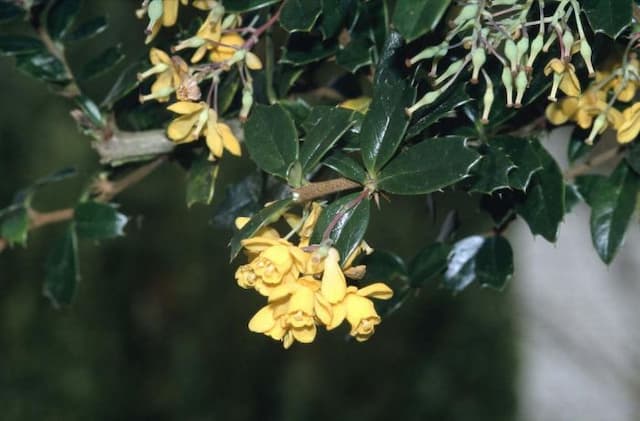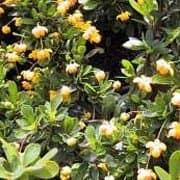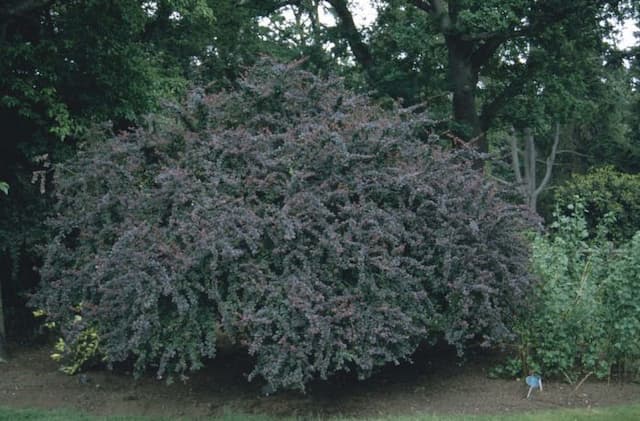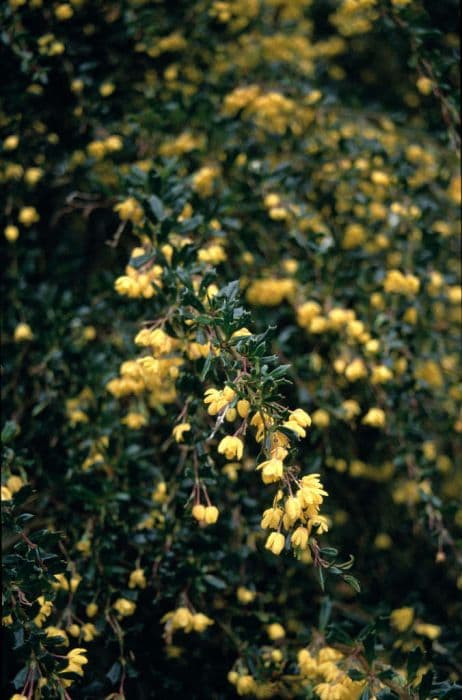Twinleaf Jeffersonia diphylla

ABOUT
Jeffersonia diphylla, commonly known as twinleaf, is a perennial plant with a distinctive appearance, including a duo of broad, nearly identical leaflets, which together make up a single, butterfly-shaped leaf. Each pair of leaflets is deeply lobed with a smooth texture. The leaf stems rise from the base of the plant, forming a low, basal rosette. In the blooming season, the twinleaf produces delicate, white flowers that have eight petals each and are poised on slender stalks that tower above the foliage. These flowers have a simple yet elegant look, with a prominent central cluster of yellow stamens. After the flowers bloom, the plant develops a capsule-like fruit that sits atop a thick stalk. The overall foliage of the twinleaf is a vibrant green, providing a lush background for the bright white of the blooms. The twinleaf's leaves and flowers together create a striking contrast, making it a charming addition to woodland gardens and shaded areas.
About this plant
 Names
NamesFamily
Berberidaceae
Synonyms
Twinleaf, Rheumatism Root, Helmet Pod
Common names
Jeffersonia binata
 Toxicity
ToxicityTo humans
Jeffersonia diphylla, commonly known as twinleaf, is not widely recognized for having toxic properties to humans. There is limited information about its toxicity, and it is generally not considered a major concern. However, as with any plant, individual sensitivities can occur, and it is advisable to avoid ingestion due to the lack of comprehensive studies on its effects. If you suspect poisoning from any plant, including twinleaf, seek medical attention.
To pets
Twinleaf (Jeffersonia diphylla) is not known to be toxic to pets such as dogs and cats. There is no significant evidence to suggest that pets would suffer from poisoning after ingesting this plant. As with any non-food plant, ingestion of large quantities could potentially cause gastrointestinal upset in some animals due to irritation or sensitivity. If signs of distress occur after your pet has consumed twinleaf, consult with a veterinarian.
 Characteristics
CharacteristicsLife cycle
Perennials
Foliage type
Deciduous
Color of leaves
Green
Flower color
White
Height
1 foot (0.3 meters)
Spread
1 foot (0.3 meters)
Plant type
Herb
Hardiness zones
5
Native area
Eastern North America
Benefits
 General Benefits
General Benefits- Ecosystem Support: Provides habitat and food for pollinators such as bees and butterflies when in bloom.
- Ornamental Value: Exhibits beautiful white flowers in spring that add aesthetic value to gardens and natural landscapes.
- Native Plant: Being indigenous to Eastern North America, including it in landscaping supports local biodiversity and ecosystems.
- Shade Tolerance: Can thrive in shaded areas, making it a suitable ground cover for woodland gardens or shaded borders.
- Low Maintenance: Once established, it requires minimal care, making it a convenient choice for gardeners of all levels.
- Spring Interest: One of the early bloomers in spring, providing visual interest after the winter months.
- Naturalizing: Can spread and form clumps, allowing for naturalistic planting schemes in gardens and parks.
- Seasonal Foliage: Features twin, lobed leaves that offer textural contrast in garden compositions.
- Fall Interest: Leaves may turn a golden-yellow color in fall, providing additional seasonal charm.
 Medical Properties
Medical PropertiesThis plant is not used for medical purposes.
 Air-purifying Qualities
Air-purifying QualitiesThis plant is not specifically known for air purifying qualities.
 Other Uses
Other Uses- Jeffersonia diphylla, commonly known as twinleaf, has been used historically as a dye plant, with its roots providing a strong yellow pigment.
- The seed capsules of twinleaf have an interesting architectural shape and can be used in dried flower arrangements.
- Some gardeners use twinleaf as a teaching tool in botany classes due to its distinct two-leaf structure that provides a clear example of dicotyledonous plants.
- In landscaping, twinleaf offers early spring flowers that can be an important nectar source for pollinators when not many other plants are in bloom.
- Its unique foliage can provide textural contrast when planted alongside more common garden perennials.
- The plant has been referenced in Native American cultural stories and education, making it useful for cultural heritage and interpretative gardens.
- Due to its rarity in the wild, Jeffersonia diphylla can be used for conservation education to stress the importance of woodland habitat preservation.
- Twinleaf seeds possess elaiosomes, making them interesting for studies on ant-seed mutualism where ants disperse seeds in exchange for the lipid-rich elaiosomes.
- Its resilience in shade makes it a candidate for understory planting in forested areas or restoration projects.
- Schools and botanical gardens sometimes use Jeffersonia diphylla to demonstrate early American botanical history, since it was named in honor of Thomas Jefferson.
Interesting Facts
 Feng Shui
Feng ShuiThe plant Jeffersonia diphylla, commonly known as Twinleaf, is not used in Feng Shui practice.
 Zodiac Sign Compitability
Zodiac Sign CompitabilityThe plant Twinleaf is not used in astrology practice.
 Plant Symbolism
Plant Symbolism- Rarity: Jeffersonia diphylla, commonly known as Twinleaf, is a relatively rare woodland plant, which can symbolize uniqueness and preciousness due to its scarcity in nature.
- Duality: The name "Twinleaf" refers to the plant's leaves, which usually come in pairs. This can symbolize balance, duality, and complementarity in relationships or situations.
- Medicinal Properties: Historically, Twinleaf was used by Native Americans for various medicinal purposes, which can symbolize healing, protection, and nurturing.
- Spring Awakening: As Twinleaf blooms in early spring, it can symbolize new beginnings, renewal, and the awakening of life after winter.
- Connection to History: The plant is named after Thomas Jefferson, symbolizing a connection to American history, tradition, and intellectual heritage.
 Water
WaterTwinleaf (Jeffersonia diphylla) prefers consistently moist soil, so watering should be done to maintain soil moisture without causing water to stand, which can lead to root rot. In general, water the plant once a week with approximately one gallon of water per square yard. During hot or dry spells, increase the frequency of watering to twice a week. In the dormant season, reduce watering but ensure the soil does not become completely dry. It's best to water early in the morning or late in the afternoon to minimize evaporation. Avoid overhead watering to keep the foliage dry and prevent the spread of diseases.
 Light
LightTwinleaf thrives in dappled sunlight to light shade conditions. It is ideally placed in an area where it can receive filtered sunlight throughout the day or under the canopy of taller trees and shrubs. This simulates its natural woodland habitat and protects the leaves from harsh afternoon sun, which can cause scorching or stress to the plant.
 Temperature
TemperatureTwinleaf is hardy and can withstand a temperature range from just above freezing to about 85°F. The ideal temperature range for Jeffersonia diphylla is between 60°F and 75°F, which is typical of its native woodland environments in spring. Extreme heat or cold can be detrimental to the health of the plant, so ensure appropriate mulching to protect it in winter seasons.
 Pruning
PruningPruning of Twinleaf is typically to remove spent flower stalks and to tidy up the plant if necessary. Prune immediately after blooming to encourage a neat appearance. It is not necessary to prune this plant heavily, as it maintains its form naturally. Once a year after flowering is sufficient for pruning needs, and it helps to prevent the plant from self-seeding excessively if not desired.
 Cleaning
CleaningAs needed
 Soil
SoilTwinleaf requires a well-draining, humus-rich soil with a pH range of 6.0 to 7.0. For optimum growth, mix garden soil with leaf mold, compost, and some coarse sand to improve drainage and mimic its natural woodland habitat.
 Repotting
RepottingTwinleaf does not require frequent repotting; it can be repotted every 2-3 years or when it outgrows its current container, though it's typically grown in garden settings rather than pots.
 Humidity & Misting
Humidity & MistingTwinleaf thrives best in moderate humidity levels, reflective of its natural woodland environment, but it does not require any special humidity considerations beyond those typically found outdoors in its native range.
 Suitable locations
Suitable locationsIndoor
Provide shade, cool temps, and moist soil for Twinleaf indoors.
Outdoor
Plant Twinleaf in dappled shade with moist, rich soil outdoors.
Hardiness zone
4-8 USDA
 Life cycle
Life cycleJeffersonia diphylla, commonly known as twinleaf, begins its life cycle when the seeds germinate in early spring, often aided by the cold stratification process over winter. Seedlings emerge with a pair of cotyledons before developing the characteristic twin, almost mirror-image leaves that give the plant its name. The plant enters the vegetative stage, where it grows and matures, generating more leaves and establishing a robust root system. In spring, twinleaf produces white flowers on erect stems that, once pollinated, develop into capsules containing seeds. After flowering, the plant enters a period of senescence in late summer, where above-ground parts die back, and the plant relies on energy reserves stored in the rhizomes to survive the winter. The cycle repeats the following spring, with rhizome buds sprouting new shoots that continue the growth of the plant.
 Propogation
PropogationPropogation time
Spring-Early Summer
Propogation: Twinleaf, or Jeffersonia diphylla, is best propagated by seed. The ideal time to sow the seeds is in fall, directly after they ripen to ensure that they undergo the required period of cold stratification naturally during winter. The stratification process breaks dormancy and encourages germination. Sow the seeds at a shallow depth of about an inch or less in a shaded area, simulating their natural woodland environment. Germination is slow, often taking a full year or more, which requires patience from the gardener. Once germinated and grown to a suitable size, the seedlings can be carefully transplanted to their desired location in the garden.









